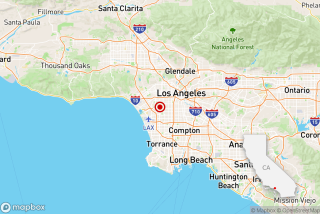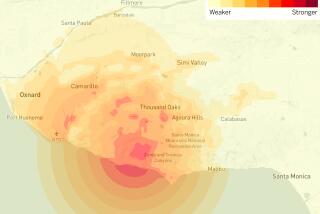L.A. OKs Hollywood skyscrapers despite quake concerns
The Los Angeles Department of Building and Safety has signed off on geology reports that found that no active earthquake fault runs under the site of the Millennium Hollywood development, even though the state geologist last year concluded there was one.
The move ends a controversial two-year debate over whether two massive skyscrapers could be built safely due to seismic conditions.
New studies completed for the city by Millennium’s geologist concluded an earthquake fault was probably located deep beneath the property. But city officials agreed with the developer that the fault was too old to be considered active.
The conclusion is markedly different from those made by state geology officials, who had analyzed previous data and said last year that an active fault slices through part of the project site, south of the Capitol Records tower.
“Our conclusion from the data is that there is an active fault, and it does run right along the course that’s right along the map,” state geologist John Parrish told the Times last November when his agency, the California Geological Survey, released its regulatory map of the Hollywood fault.
California law defines faults that ruptured within the last 11,000 years as active. The Hollywood fault was forced into the spotlight in 2013, when the L.A. City Council approved the Millennium project even after state officials said the project might lie in an active earthquake fault zone.
The California Geological Survey accelerated its analysis and mapping of the Hollywood fault, which stretches from the Sunset Strip in West Hollywood to Atwater Village. Under state law, developers in the fault zone are generally required to prove that new buildings can be constructed safely away from any active faults.
The final say over whether a structure can be built lies with city building officials, who must determine whether a developer has done sufficient underground study.
State officials Monday said the city’s approval will not change the current Hollywood fault map. Tim McCrink, who manages the state’s Alquist-Priolo Earthquake Fault Zoning program, said the law worked the way it was supposed to.
“The zone maps have done exactly what they’re intended to do – focus the attention on where we think the faults lie,” he said. “It’s in the city of L.A.’s hands at this point.”
Studies by Millennium’s geotechnical consultant, Group Delta, showed that there is probably a fault deep below the property that roughly follows the path indicated on the state’s zoning map. However, contrary to the state’s conclusions, the studies showed that the inferred fault was estimated to be at least 150,000 years old.
City officials in June agreed with this conclusion, which was also reviewed by a third-party firm, Earth Consultants International.
As a precaution, two corners of the Millennium site are restricted from construction because the seismic studies did not extend beyond the property boundary. “Construction of buildings within these setback zones will be considered if additional geologic exploration is conducted and the areas are found to be free from active faults,” according to the city’s approval letter.
Philip Aarons of New York-based Millennium Partners said in a statement Monday that Millennium’s seismic studies took the state geologist’s conclusions into account and that it “provides the most detailed and rigorous subsurface analysis ever undertaken of urban geologic conditions in Hollywood.”
Group Delta has also completed detailed seismic studies under three nearby properties, including the site of the former KFWB radio studio. Chief Executive Michael Reader has told the Times that his firm dug four trenches and took dozens of soil and sonar samples, which so far have cost the developers well over $1 million.
Reader said working on all four properties was like piecing together a “geological jigsaw puzzle,” and that his firm was able to reach its conclusions only because they were hired and had access to study all the locations at the same time. Group Delta did find minor faults under the two properties across the street from the Millennium and KFWB sites, but tests showed these faults were also too old to be considered active.
City building officials have also approved these seismic studies in recent months. Officials specified in their approval letters that during construction, the projects’ engineering geologists must observe all excavations to verify there are no active faults under the properties.
A supplemental report of these observations, including photographs and logs of excavations, must be submitted to the city, and “if evidence of active faulting is observed, the Grading Division shall be notified immediately,” the approval letters said.
Reader in the past has asked the state to reflect his findings in its final zoning maps. He questioned whether the California Geological Survey had enough evidence to support designating an active fault zone through the four properties.
The state agency has not reviewed the latest Millennium study thoroughly enough to see if there’s any new information that would prompt changing the zoning map, McCrink said Monday. “At this point, we’re going to just leave the zones as they are until we get some very conclusive evidence that those faults truly are inactive.”
McCrink cautioned that inactive faults can still be a concern – what scientists call a low-probability, but high-impact risk.
“The definition of what is an active fault is a man-made call,” he said. “There have been a number of cases where faults that hadn’t moved in 20,000 or 30,000 years have now ruptured in historic time.”
Nearby residents and opponents of Millennium have legally challenged the project. They have been vocal about its seismic safety and said Hollywood is ill-equipped to handle the additional traffic that the development would bring.
The project was put on hold in May after a Los Angeles County court ruling found that the city of L.A. failed to fully assess how the $1-billion development would affect traffic and surrounding neighborhoods. The ruling prevents the city from granting building permits for the project, pending whether the developer drafts a new environmental impact report.
Millennium officials pledged to continue the effort to build the project, which would replace parking and rental car lots next to the Capitol Records tower.
“Millennium Hollywood remains firmly committed to building a project that will preserve the iconic Capitol Records building and revitalize Hollywood’s historic Downtown, doing so in a manner that conforms to the highest earthquake resiliency standards,” Aarons said Monday.
Follow @RosannaXia for more news about seismic safety.
ALSO:
Helium finding adds new wrinkle to Newport-Inglewood fault
California budget will fund 1,000 single-family home retrofits
Judge halts Millennium Hollywood skyscraper project
More to Read
Start your day right
Sign up for Essential California for news, features and recommendations from the L.A. Times and beyond in your inbox six days a week.
You may occasionally receive promotional content from the Los Angeles Times.







